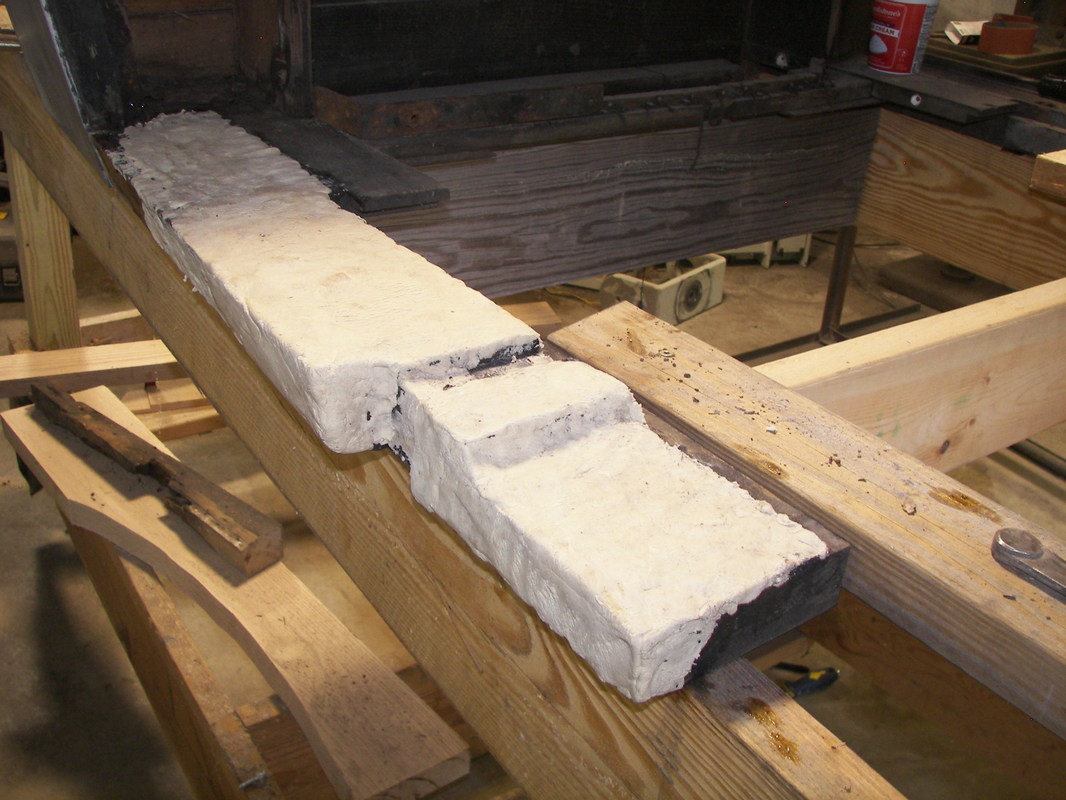|
The following article is Part Two of Steve Bragg’s story of his family’s restoration of their 1922 Model 740B Stanley Steam car. Finishing the Mechanical Renovations. The fire wall was carefully removed and the rotted wood replaced and reconstructed. A new aluminium plate was also fabricated and installed with new fasteners, all matching to the original steel slotted screws. During the mechanical restoration, we are careful to match all of the original style fasteners, no phillips screws, all slotted, fillister head screws, square head, heavy hex and flat head bolts were all carefully matched and replaced as needed. Good sources for correct fasteners are McMaster-Carr (mcMaster.com), Restoration Specialties & Supply, (restorationspecialties.com), Restoration Supply Company (restorationstuff.com), my wife seems to think they deliver every day to my workshop. The front cross member was moved forward to accommodate the larger boiler. All the valves and fittings were refurbished and packed. A few required replacement – those were sourced from the J.R. Goold in England (stanleysteamcarparts.co.uk), Howard Johnson (Steam Works Ltd) and Don Hoke (Vintage Steam Products). The steam automatic was rebuilt and calibrated, the fuel automatic was also rebuilt and tested along with the water automatic. The relief valve was rebuilt and tested (it relieves quite nicely about 750 psi). The kidney gauge was also dissembled, cleaned, restored and water level indication verified. An additional level indication was also added in the form of an Ernst sight glass. The water automatic, kidney gauge and sight glass were all tested individually and as a group to verify tracking and function – all of this was done cold and after initial steaming. The Smoke Hood With the over-sized Bourdon Boiler, the smoke bonnet had to be re-fabricated. 308 stainless steel sheet, .032” (.813mm) was cut into circles, fitted to wooden forms and hand hammered into the proper shape. An inner and outer shell, like the original, was fabricated, then insulated with mineral wool. All of the insulation is completely covered in the sheet metal, including curved angled caps, so that the inner wall sits directly on the top of the boiler per the original design. It makes a good smoke tight seal. A new exhaust down comer was also fabricated and it also seals and drafts nicely. Water Tank and Drive Covers The tank was taken off of the car for cleaning and repairs. Although the tank did not leak, the top and water return did have a few spots where solder was needed. There was still water (although very nasty) from the last time the car was operated, it had not fully evaporated. The steam siphon was also cleaned and reattached to the support on the tank top. Upon trusted advice, a tank cap was added to the copper water tank and while the tank was opened, the interior was further cleaned. A large amount of hardened sludge was removed after some painstaking work. The water intake screen was also carefully cleaned and re-installed. New hangers and strapping were also made. The tank was cleaned (for final appearance) with technical grade citric acid mixed to a solution of 5-10%. The cleaning solution turned a nice green colour and the result was too nice to paint like was done at the factory. The engine cover was fairly well bent up and required some attention so after some hand work, it was straight and shiny like a new copper penny. The mid band (to cover the engine packing) was missing but luckily an almost perfect one turned up in the Stanley Museum Auction in 2012. The covers will be installed once the second engine is installed in the next couple of months. The pump rod cover was in terrible shape, it apparently had been badly mangled in the wreck and requires a new one to be made. That is still in progress but is being fashioned out of copper sheet to look like the engine cover and water tank. The original was galvanized but all of the copper (now unpainted) begged for a similar cover for the pump rod. The Condenser The condenser shroud was bent and coming apart where it was soldered together. It was taken completely apart, cleaned, re-soldered and then nickel plated. The condenser core was found to leak so we refurbished it and re-soldered all joints. The 740 condenser was quite a challenge to stop all of the tube sheet leaks so a few of the tubes were flared again at the top and once flared, soldered an in a few cases some extreme temperature (>2300F) epoxy was used. The condenser cap was broken, all of the Bakelite was missing. A condenser cap proved almost impossible to location, none could be found for sale so I resorted to making a new one. I found one for loan so I could cast a mold. From there I used a modern two part epoxy of the correct specification to make an identical replica. My custom designed jig allowed me to make replacement caps. I have produced several (contact me for information). The loaner for the mold was captured in exact detail so even the scratches were duplicated down to the colour, weight and feel. Sitting side by side, the original and replica are identical. The Burner The new Bourdon Boiler was also purchased with a new burner. The original mounting clamps were salvaged but a new mounting ring and new super heater ring were fashioned. This resulted in a very tight seal on the burner to boiler connection that is sealed with flat surfaces, bolts and high temperature fiber gasket. So far, there have been no indications of air leakage. After seeing Howard Johnson's temperature indication for his 1916 Stanley, I knew I wanted to make this addition to our car. I was able to locate a proper thermocouple and a period correct meter that all functions quite nicely. I have assembled several meter kits that are available for sale (contact me for details). The added thermocouple, when tested with a modern millivolt meter, and compared to the thermocouple table, have proven to be extremely accurate, checked against a laser thermocouple and the proper tables, the meter setup is within 5 degrees accuracy. With just the pilot lit and at operating temperature, the meter will register 250-290F and at full fire, almost 600F. This gives a high confidence level of the burner's operating condition and with the sight glass also, quick response for upset conditions. The Body Except for the front fender and splash aprons, the body at first appeared to be very in solid shape but the top had fallen in so there was some concern. Further investigation though revealed a great deal of rot under the aluminium skin. This discovery resulted in the wood work taking a great deal of time to complete but the results have been worth it. Once the skins were removed we could inspect and see the extent of the repairs needed. By use of some modified pliers, small chisels and a lot of patience, all of the tiny nails and brads were removed. There were hundreds to remove. We decided to salvage as much of the wood framed body as possible, as a result the work took over a year to complete. The rotten and damaged wood was carefully removed and replaced with new wood. Jointing of all replacement sections into the original was carried out in an attempt to keep to the precise shape and style. Good quality glue was used as well as mortise and tenon joints. In some of the joints, only tenons and pegs, along with glue, was used. Original style slotted wood screws were also used, hopefully meaning the longevity of the wooden frame would last for few more decades to come. On one of the rear sections, at the driver rear door, there was only surface rot present. I found an epoxy made of wood based products that was designed to repair surface rot. The rotten wood was drilled every ½" to make a grid of holes to get to good solid wood, then treated with ethylene glycol to kill the organisms present. That takes the glycol 203 weeks to kill everything. A two part epoxy filler was then carefully applied and when hardened, created a solid surface repair to the rotten wood. This was sanded and reshaped and could be drilled, and was in fact as strong or stronger than the original wood. This is an excellent means of repairing surface rot. Some interesting notes: The body for our car was made by the Shields Carriage Company in Massachusetts. The wood used for the rear seat supports was apparently wooden slats from the shipping pallets. The top material was also apparently supplied by the Troy Sun Shade Company. After researching both of these companies, both have very interesting history's with Stanley (that will have to be a chapter in the yet to be written book). The wood in the photos below is original to the car, the body was made by the Shields Carriage Company, the top materials from the Troy Sun Shade Company. This wood and as you can see, looks to be shipping pallet material and the lettering was preserved with the car. Now that we were satisfied that the wood framework of the body was completed, we turned to the aluminium body work.
We will talk about that in part 3 of this story.
0 Comments
|
Archives
December 2022
Categories
All
|
|
|
Steam Car Network functions as a resource for all steam car and steam bike enthusiasts. The website is constantly updated with articles, events, and informative posts to keep the community alive and growing. Feel free to contact us if you have any questions or concerns at the email address below and we will promptly reply.
[email protected] |



 RSS Feed
RSS Feed
